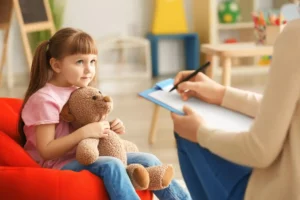Navigating the realm of childhood and adolescence has never been more challenging, with today’s youth encountering a myriad of unique pressures and obstacles. Child therapists serve as beacons of support and understanding, guiding children and their families through the tumultuous waters of emotional and psychological distress. This article delves into the intricate world of child therapy, illuminating the diverse approaches employed by child therapists and a few tips to find them near you.
Contents
Who Needs A Child Therapist?
 The need for a child therapist can arise for a variety of reasons. And children from all walks of life might benefit from therapeutic support at some point. Here are some scenarios and circumstances where a child might need a therapist:
The need for a child therapist can arise for a variety of reasons. And children from all walks of life might benefit from therapeutic support at some point. Here are some scenarios and circumstances where a child might need a therapist:
- Emotional and Behavioral Challenges: Children who exhibit signs of anxiety, depression, aggression, frequent mood swings, or other emotional and behavioral challenges might benefit from therapy.
- Developmental Delays: Children who show signs of developmental delays, whether cognitive, social, or emotional, might see a therapist to support their growth and skills acquisition.
- Academic Struggles: If a child is consistently struggling academically or resisting going to school, it might indicate underlying issues. Such as learning disabilities, bullying, or emotional distress. And a therapist can help address this.
- Social Challenges: Children who have difficulty making friends, frequently get into conflicts with peers, or seem isolated may benefit from therapeutic support to develop social skills and self-confidence.
- Witnessing Violence: Children who have witnessed violence, whether at home, in school, or in their community, might need therapeutic support to process what they’ve seen and learn coping strategies.
- Identity and Self-Esteem Issues: As children grow and develop, they might struggle with issues related to their identity, body image, or self-worth. Therapists can help them navigate these feelings.
- Adoption or Foster Care: Children who have been adopted or are in foster care might face challenges related to attachment, identity, or trauma. Therapeutic support can be beneficial in such cases.
It’s important to note that while these are common scenarios in which children might need a therapist, every child is unique. Some might need therapy for reasons not listed here, while others might navigate these situations without the need for therapeutic support.
How Does A Child Therapist Help?
A child therapist plays a crucial role in understanding, supporting, and helping children navigate the myriad challenges they might face. They employ specialized techniques tailored to the child’s age, developmental stage, and the issues at hand. Here’s how a child therapist can help:
- Building Trust
One of the first steps in therapy is establishing a trust-based relationship. There, the child feels safe to express their feelings and concerns.
- Providing a Safe Space
A therapist offers a neutral and confidential environment. And children can express their thoughts and emotions without fear of judgment.
- Assessment
Through observation, interaction, and sometimes formal testing, therapists assess the nature and severity of the child’s challenges.
- Education
Therapists educate children about their emotions, reactions, and behaviors. Ultimately, helps them understand and normalize their experiences.
- Referrals
If a child has needs outside the therapist’s expertise, such as medication or specialized services. Then, the therapist can guide families to appropriate professionals or resources.
- Setting Goals
Therapists work with the child (and often the family) to set therapeutic goals. And, creating a roadmap for what they hope to achieve through therapy.
- Validation
By acknowledging and validating a child’s feelings and experiences, therapists help boost their self-worth and confidence.
- Feedback and Progress Monitoring
Regular feedback helps adjust therapeutic strategies as needed. Also, it will help to ensure the child is making progress.
In essence, child therapists provide a multifaceted support system. All of which aim to alleviate immediate distress while also equipping children with tools and strategies to handle future challenges.
What Common Techniques Are Used By Child Therapists?
 Child therapists utilize a range of techniques tailored to the preferences of the child they’re working with. These techniques aim to facilitate communication, understanding, and healing. Here are some common techniques:
Child therapists utilize a range of techniques tailored to the preferences of the child they’re working with. These techniques aim to facilitate communication, understanding, and healing. Here are some common techniques:
Play Therapy
Play therapy is a cornerstone of child psychotherapy. Recognizing that children might not have the vocabulary or comfort level to articulate complex emotions or experiences, play therapy offers an alternative medium of expression. By engaging in structured or unstructured play, children can project their inner worlds, fears, hopes, and traumas onto toys, dolls, and scenarios they enact.
Art Therapy
Art, much like play, is a natural form of expression for many children. In art therapy, children are encouraged to draw, paint, sculpt, or engage in other creative processes to articulate their feelings and experiences. A drawing of a family, for instance, might offer insights into a child’s perception of family dynamics. Colors, shapes, the intensity of strokes, and even the choice of subject can offer clues about a child’s emotional state.
Cognitive-behavioral therapy (CBT)
CBT is rooted in the understanding that our thoughts, feelings, and behaviors are interconnected. In CBT, children are introduced to this interplay and taught to recognize negative or distorted thought patterns that might lead to maladaptive behaviors or feelings. Through discussions, worksheets, role-playing, and other interactive activities, children learn to challenge these unhelpful thoughts and replace them with more positive or realistic ones.
Sand Tray Therapy
Sand tray therapy provides children with a “miniature world” where they can project their feelings, fears, and fantasies. A tray filled with sand becomes the canvas, and an assortment of miniature figures – ranging from animals to mythical creatures to everyday objects – serve as the medium of expression. By creating scenes in the sand, children can symbolically represent their inner worlds. This can be especially therapeutic for those struggling to verbalize their feelings.
Animal-Assisted Therapy
 The therapeutic power of animals lies in their unconditional acceptance and non-judgmental nature. In animal-assisted therapy, trained animals, often dogs or horses, are introduced into the therapeutic setting. For a child struggling with trust or self-esteem issues, genuine affection from an animal can be profoundly healing. Caring for animals can also teach children about responsibility, empathy, and compassion.
The therapeutic power of animals lies in their unconditional acceptance and non-judgmental nature. In animal-assisted therapy, trained animals, often dogs or horses, are introduced into the therapeutic setting. For a child struggling with trust or self-esteem issues, genuine affection from an animal can be profoundly healing. Caring for animals can also teach children about responsibility, empathy, and compassion.
Music Therapy
Music resonates deeply with human emotions. In music therapy, children are encouraged to explore their feelings through melodies, rhythms, and lyrics. They might create music, sing, or simply listen and reflect. A particular song might evoke memories or emotions, providing a starting point for therapeutic discussions. Creating music can also empower children, offering them a sense of accomplishment and a medium to express complex feelings.
Family Therapy
Children don’t exist in isolation; their well-being is closely tied to family dynamics. Family therapy brings together family members to address communication issues, conflicts, or other challenges affecting the child. Through guided discussions, role-playing, and other interventions, therapists can help families develop healthier communication patterns and create a more supportive environment for the child.
Relaxation Techniques
Children, like adults, can benefit immensely from techniques that promote relaxation and stress reduction. Through guided exercises like deep breathing, progressive muscle relaxation, and visual imagery, children can learn to manage acute episodes of anxiety or anger. These techniques offer immediate relief and can be tools that children carry with them, using them whenever they face stressful situations.
Each of these techniques, when applied thoughtfully and tailored to individual needs, can be a powerful tool in a child therapist’s toolkit. And, aiding in the holistic development and emotional well-being of young clients.
How To Find The Right Child Therapist Near Me?
 Finding the right child therapist is crucial for a successful therapeutic experience. A therapist who can build rapport with your child and understand the specific challenges they face will make a significant difference. Here’s a guide to help you find the right child therapist near you:
Finding the right child therapist is crucial for a successful therapeutic experience. A therapist who can build rapport with your child and understand the specific challenges they face will make a significant difference. Here’s a guide to help you find the right child therapist near you:
Referrals and Recommendations
Start by asking your pediatrician, school counselor, or other healthcare professionals for recommendations. Personal referrals from trusted friends or family members who’ve had positive experiences can also be invaluable.
Insurance Provider
Contact your health insurance provider for a list of in-network therapists. This can help you find a therapist that will be covered by your insurance, reducing out-of-pocket expenses.
Online Platforms
Websites like TherapyMantra, MantraCare, and TherapyRoute allow you to search for therapists based on location, specialization, and other criteria.
Check Qualifications
Once you have a few names, research their qualifications. It’s important to ensure they are licensed in your state and have relevant training and experience in child therapy.
Initial Consultation
Before committing, consider scheduling an initial consultation, either in person or over the phone. This will give you an opportunity to ask questions, discuss your child’s needs, and gauge whether the therapist might be a good fit.
Specialization
If your child has specific issues, like ADHD, autism, trauma, or anxiety, look for therapists who have experience or specialized training in that area.
Location and Availability
Practical considerations matter. Is the therapist’s office conveniently located? Do their office hours align with your schedule? Are they available for emergencies?
Comfort Level
After the initial session or two, check in with your child to see how they feel about the therapist. It’s essential that your child feels safe, understood, and comfortable.
Trust Your Instincts
Your intuition as a parent or guardian is valuable. If something feels off or if you’re not confident in a therapist’s ability to support your child, it might be worth considering other options.
Finding the right child therapist can take time and effort. But the investment is worth it. Remember, therapy is a partnership, and the right therapist can make a world of difference in your child’s well-being and development.
Conclusion
In the intricate journey of childhood, navigating emotional and psychological challenges can be daunting for both children and their caregivers. Finding the right child therapist becomes an instrumental step in ensuring that a child receives the best support possible. By relying on professional referrals, thoroughly researching qualifications, and, importantly, trusting one’s instincts, caregivers can find a therapist who resonates with the child’s unique needs.
Ultimately, the goal is to foster a nurturing therapeutic environment where children can thrive, grow, and emerge resilient, with a foundation of robust emotional well-being. Hence, online therapists are increasingly important in today’s world because they provide a convenient and accessible way for people to receive mental health support. Visit TherapyMantra for today for affordable Online Therapy: Book a trial Online therapy session.


